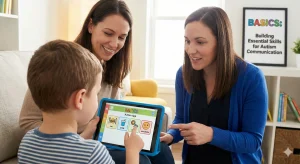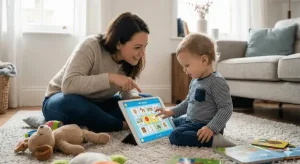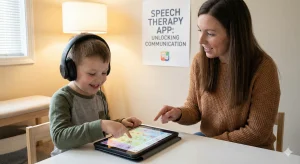Occupational Therapy for Autism: A Parent’s Guide
By Wellness Hub
Last Updated: October 29, 2025
When your child is diagnosed with autism, you’re flooded with questions — How can I help them learn? How do I make daily life easier? One of the first supports most parents hear about is occupational therapy (OT). But what exactly does it do? How does it help? And what can you expect as a parent?
Let’s walk through this together, step by step — in plain, real-life terms.
What Is Occupational Therapy and How Does It Help Children with Autism?
Occupational therapy is all about helping children gain independence in their everyday life. It focuses on the small but meaningful skills — holding a spoon, brushing teeth, writing, dressing, focusing, and even playing with others.
For children on the autism spectrum, OT goes deeper. It helps them:
- Understand and respond to sensory input
- Build attention and focus
- Develop social participation through play
- Strengthen fine and gross motor coordination
- Feel calmer and more confident in routines
In simple words, occupational therapy bridges the gap between your child’s current abilities and daily life demands.
Many autistic children experience challenges with sensory regulation — loud noises, textures, or bright lights may feel overwhelming. OT helps them process this input better, making the world feel a little less chaotic.
Key Benefits of Occupational Therapy for Children with Autism
Every parent wants to see progress — not overnight, but little steps that add up.
Here’s how OT brings real change:
- Improves focus and attention: Through sensory-rich activities, children learn to sit longer, follow directions, and complete small tasks.
- Enhances fine and gross motor skills: OT strengthens hand-eye coordination, helping with dressing, feeding, and handwriting.
- Supports sensory regulation: Children learn how to handle textures, sounds, and movements calmly.
- Builds independence in daily living: OT nurtures everyday skills — brushing, eating, toileting, and organizing tasks.
- Boosts confidence and emotional control: With practice and praise, kids learn that effort brings success.
These improvements may look small day to day, but over months, they transform how your child experiences the world.
Also read: At-Home Occupational Therapy for Autism | Calming & Fun Ideas
What Happens in an Occupational Therapy Session?
Parents often wonder, What does my child actually do in a session?
A typical OT session looks something like this:
- Assessment: The therapist observes your child’s strengths and struggles — from sensory responses to muscle tone and play behavior.
- Goal setting: Together with parents, the therapist sets achievable goals, such as “improve utensil grip” or “tolerate grooming.”
- Therapy activities: Play-based exercises follow — climbing, coloring, threading beads, swinging, or using therapy putty.
- Sensory integration tasks: These help balance over- or under-sensitivity (for example, calming deep-pressure hugs or alerting movement games).
- Parent involvement: You’re guided on what to repeat at home to build consistency.
Every session feels like play to your child — but each moment is carefully designed to strengthen specific life skills.
Read more: How Occupational Therapy Helps Kids With Autism Thrive
Occupational Therapy Activities You Can Try at Home
Your child’s progress doubles when therapy continues at home.
Here are a few therapist-approved, fun activities you can try safely:
- Sensory bins: Fill a box with rice, beans, or sand. Hide small toys and let your child dig and find them.
- Hand-strength games: Use clothespins, playdough, or squeezing sponges during bath time.
- Balance games: Walk on a line or jump between pillows. Great for coordination!
- Obstacle courses: Create simple setups using chairs and cushions for crawling, rolling, or climbing.
- Pretend play: Encourage role play like “shopkeeper and customer” or “doctor and patient.”
- Calm-down corner: Create a cozy space with a soft mat, weighted blanket, or fidget toys for sensory breaks.
Remember — it’s not about doing it perfectly. It’s about giving your child experiences that teach movement, patience, and focus through play.
Know more: Occupational Therapy 18 Month Old: Simple Exercises to Boost Milestones
How to Choose the Right Occupational Therapist (Locally & Online)
Finding the right therapist is as important as starting therapy.
Here’s what to look for:
- Qualifications: A registered BOT/MOT professional with pediatric experience.
- Experience with autism: Ask how they handle sensory integration and behavior challenges.
- Parent involvement: The best therapists guide parents to extend therapy at home.
- Approach: Look for play-based and child-led methods rather than rigid routines.
- Trial session: One or two trial sessions help you sense comfort, connection, and trust.
Many parents today also explore online OT sessions, especially when access to therapy centers is limited. Virtual sessions can teach you to model activities at home with therapist guidance.
(Tip: Always ensure the therapist is licensed and experienced with autism care.)
When to Start Occupational Therapy
The earlier, the better.
Children’s brains are most adaptable in the first eight years — a phase called neuroplasticity.
If you notice signs such as:
- Difficulty using hands or fingers precisely
- Strong reactions to textures, noise, or touch
- Trouble following simple instructions
- Avoiding play or social interaction
…it’s wise to consult an occupational therapist right away.
Early OT intervention can prevent later struggles and improve overall functioning in school and play.
Common Challenges Parents Face (and How OT Helps)
- “My child hates brushing teeth.”
→ OT uses sensory desensitization and visual schedules to make routines easier. - “He doesn’t sit still for even two minutes.”
→ Core-strength and sensory activities improve attention and regulation. - “She avoids playing with others.”
→ Therapists use structured play to encourage social interaction. - “He gets upset with loud sounds.”
→ Sensory integration helps the child manage input gradually.
These everyday wins make life smoother not only for the child but also for the whole family.
Conclusion
Parenting a child with autism can feel like a maze at times — but occupational therapy helps you find the path. It transforms daily struggles into learning moments, turning brushing teeth, playing, or writing into achievable goals. With patience and consistency, you’ll start seeing progress that truly matters — a calmer child, smoother routines, and growing confidence.
Whether you’re beginning therapy at home or exploring occupational therapy in Hyderabad, remember that every small effort counts. Celebrate little wins, stay consistent, and lean on your therapist’s guidance. Step by step, your child will learn, adapt, and shine in their own wonderful way.
Frequently Asked Questions:
1. What is occupational therapy for autism?
Occupational therapy helps children with autism learn and practice the everyday skills they need to live more independently. It focuses on play, movement, and sensory activities that build coordination, focus, and confidence. Through guided exercises, children learn to manage textures, sounds, and emotions better — turning daily routines into opportunities for growth.
2. How does occupational therapy help a child with autism?
OT supports your child’s ability to participate meaningfully in home, school, and play settings. Therapists use sensory-based and motor tasks to improve focus, balance, and emotional control. Over time, this leads to smoother mealtimes, calmer transitions, better handwriting, and more social confidence.
3. What age should a child start occupational therapy?
Ideally, therapy begins as soon as developmental delays or sensory differences appear — often around ages 2 to 3. Early intervention takes advantage of the brain’s high flexibility in early childhood, helping children build strong foundations for communication, learning, and behavior.
4. Can OT help with communication?
Absolutely. While speech therapists directly target language, occupational therapists work on the underlying skills that make communication easier — such as attention, joint engagement, imitation, and turn-taking. By improving sensory regulation and focus, OT creates the calm and readiness a child needs to communicate.
5. How long does OT take to show results?
Every child progresses differently. Some parents notice changes within a few weeks, while others see steady gains over months. The key is consistency — attending sessions regularly and practicing at home. Progress often shows up in small but meaningful ways: better eye contact, smoother transitions, or more willingness to try new things.
6. What are common OT activities for autism?
Therapists use play to teach. Common OT activities include sensory play (with rice, sand, or water), fine motor games like threading beads or squeezing clay, gross motor activities like crawling or swinging, and pretend play to encourage imagination and social skills. Each task is personalized to your child’s comfort and developmental level.
7. Is occupational therapy expensive in Hyderabad?
In Hyderabad, session prices usually range from ₹800 to ₹1,500, depending on the center, therapist experience, and session length. Many clinics, including Wellness Hub, offer affordable therapy packages or online options that make continued sessions easier for families.
8. Can I do occupational therapy at home?
Yes — and your involvement makes a huge difference! With your therapist’s guidance, you can use daily routines as mini therapy sessions: squeezing sponges while bathing, sorting toys by color, or practicing buttoning shirts. Home practice strengthens what your child learns in the clinic.
9. How is OT different from speech therapy?
Both therapies complement each other. Occupational therapy focuses on physical, sensory, and emotional readiness — helping children regulate their bodies and attention. Speech therapy then builds on that readiness to develop communication and language. Many children benefit from both together for best results.
10. What qualifications should an occupational therapist have?
A professional therapist should hold a Bachelor’s or Master’s degree in Occupational Therapy (BOT/MOT) from a recognized institution and be licensed to practice. It’s also helpful if they have pediatric experience and training in sensory integration, especially when working with children on the autism spectrum.
About Author:
Sonali Sharma, Occupational Therapist
Sonali Sharma is a skilled Occupational Therapist at Wellness Hub, with over three years of experience in supporting children with developmental, behavioral, and learning challenges. She holds a Bachelor’s in Occupational Therapy (BOT) from Amity University and has worked with leading institutions such as NIMHANS Bengaluru and ESIC Hospital Faridabad.
At Wellness Hub, Sonali provides online occupational therapy sessions tailored to each child’s needs. She specializes in pediatric therapy, autism support, sensory integration, and developmental skill-building, helping children strengthen motor skills, improve focus, and become more independent in daily life.
Her therapy style is child-centered, play-based, and evidence-driven—making sessions both effective and enjoyable for kids. Sonali also equips parents with practical home therapy strategies to extend progress beyond sessions.
Passionate about empowering families, Sonali believes in creating a nurturing space where children can thrive while parents feel supported every step of the way.
Book your Free Consultation Today
Parent/Caregiver Info:
Client’s Details:
* Error Message








